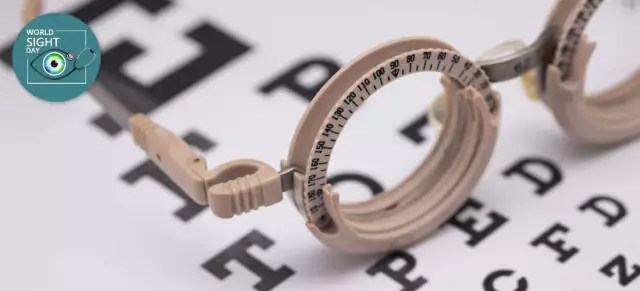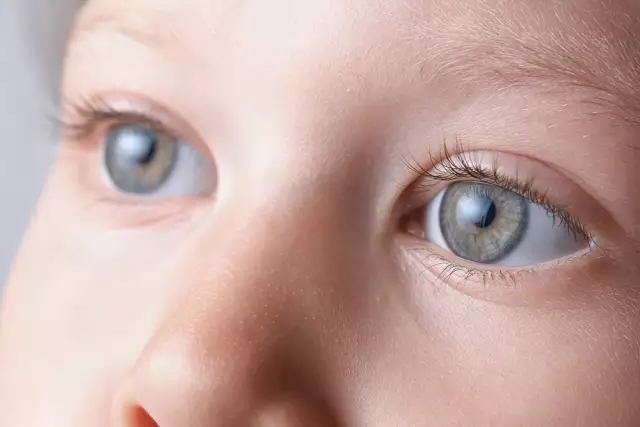- Author Rachel Wainwright [email protected].
- Public 2023-12-15 07:39.
- Last modified 2025-11-02 20:14.
How to stop age-related visual impairment?
The content of the article:
-
How the structure and functioning of the eyes changes with age
- Cataract
- Dry eye syndrome
- Age-related macular degeneration (AMD)
- Is it possible to restore vision?
- The role of peptide bioregulators in improving vision
With age, all organs of the human body undergo involution (reverse development). The organ of vision is no exception. The eyes become susceptible to negative changes associated with natural aging of the body. During this period, dry eye syndrome, cataracts, macular degeneration and other serious diseases can occur. Is it possible to stop age-related deterioration in vision and restore the eyes to their former health?
How the structure and functioning of the eyes changes with age
The older a person becomes, the more changes his organ of vision undergoes. The most common disorders that occur in the visual apparatus of men and women over 45 are cataracts, dry eyes and age-related macular degeneration.

Cataract
With age-related cataracts, the lens of the eye becomes clouded as a result of age-related changes in the body. The pathogenesis of the disease is associated with metabolic disorders in the eyes, as well as with a decrease in antioxidant protection, a deficiency of vitamins and trace elements, as well as a number of important peptides.
The disease manifests itself as partial or complete clouding of the pupil, blurred vision, decreased color perception, flashing flies in front of the eyes, and increased sensitivity to light.
Cataract is one of the most common ophthalmic diseases in old age. According to statistics, at 50-60 years old, the disease is diagnosed in 15% of people, at 70-80 years old - in 30-40%, and by the age of 80, almost everyone has pathology.
Dry eye syndrome
With aging of the body, the fluid produced by the lacrimal glands becomes less, the tear film begins to be insufficient for comfortable vision. A person is faced with symptoms such as dryness, stinging and burning in the eyes, a feeling of the alleged presence of sand in them, watery eyes, redness of the eyes, and photophobia.
Dry eyes are most commonly experienced by women during menopause. This is due to endocrine changes, in which there is a decrease in the level of estrogen in the body. The result of hormonal imbalance is dryness of the mucous membranes (including the conjunctiva).
Age-related macular degeneration (AMD)
With age-related macular degeneration, dystrophic changes occur in the retina of the eye. The disease is the result of a slowing down of metabolism in the retina, which affects the cells of its central part (macula). Distinguish between dry and wet form of AMD. The most dangerous is the wet form - it is characterized by rapid development and a high risk of complete loss of vision.
Symptoms of age-related macular degeneration: decreased visual acuity (not corrected with spectacle correction), deterioration in color perception, distortion of objects, the appearance of a dark spot in front of the eyes.
Is it possible to restore vision?
Modern medicine has several ways to restore vision. The most commonly used methods are:
- laser vision correction;
- surgery to replace your lens with an artificial analogue;
- implantation of an actual lens.
In some cases, gymnastic exercises for the eyes will help to stop age-related deterioration in vision. The whole set of exercises will not take more than 10-15 minutes a day, and the strengthening of the eye muscles can be noted already from the first month of gymnastics.

- Eye massage. You need to close your eyes and lightly massage them with your fingertips. Movements should be smooth, circular. At the end of the exercise, you should close your eyes tightly and open your eyes.
- Blinking. To perform the exercise, you need to blink intensely for 30-40 seconds.
- Rotation of the eyes. Keeping your eyes open, you should make movements up, down, left, right and in a circle. You need to do 3 repetitions.
- Change of focus. During the exercise, you need to find the tip of your nose with your eyes, and then focus your gaze on a distant object. Repeat 5-6 times.
- Head turns. When performing the exercises, it is necessary to make slow turns of the head, followed by focusing on the objects that appear, then on the left side, then on the right. The number of repetitions is 5-6.
Special drops containing synthetic analogs of human tears can cope with dry eye syndrome. Regular instillations can significantly improve quality of life.
The role of peptide bioregulators in improving vision
Unfortunately, not all ophthalmic diseases can be corrected with eye drops, gymnastic exercises or surgery. For example, an advanced form of age-related damage to the retina (age-related macular degeneration) is irreversible. And with the transition of the dry form of WDM to the wet one, you can completely lose sight without the possibility of its restoration. In order to maintain eye health and prevent the development of serious age-related changes, scientists have created special biologically active substances - peptide bioregulators.
These drugs perform several functions at once:
- stimulate reparative processes;
- improve the interaction between the pigment epithelium and the outer segments of the photoreceptors of the retina;
- help prevent the transition of a dry form of AMD to a wet one;
- normalize metabolism;
- stimulate the functions of the cellular elements of the retina;
- restore light sensitivity;
- promote the regeneration of retinal tissues;
- protect eye tissue from harmful effects.
Regular use of drugs helps to slow down and stop the process of age-related changes in vision, expand the field of vision and improve visual perception. Always look at the world brightly and clearly, and peptide bioregulators can help you with this!
Found a mistake in the text? Select it and press Ctrl + Enter.






